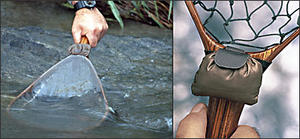
When you are on a stream for the first time, the most important thing for a fly fishing angler to do is to identify the types of aquatic insects and the stage of the hatch for those insects. From this information, the angler can intelligently select the correct fly pattern to duplicate the species and the life cycle of insects the trout are currently eating. You may select a nymph, dun, wet dun, spinner, cripple etc. depending on your findings.
Several factors will affect the type of aquatic insects that will be on any stream. The year around temperature of the water is one key factor. For example, the water high up on a mountain stream will be colder and support a narrower range of aquatic insects, while the water lower in elevation where the water has a chance to warm up, will support another type of aquatic insect. Likewise, the water flowing from an impoundment may be coming from the bottom of the lake and therefore it will be colder on a year around basis. Knowing some basis information about the aquatic insects will help in identifying them when you encounter them.
Another key factor in identifying the aquatic insects and selecting the proper fly pattern is the Ph of the water. A high Ph will invariably support a greater variety of aquatic insects and the insect population will be more bountiful as well. The trout will be fatter and more aggressive as well due to the good condition.
Well how do we go about it? First the quick and simple method is to go to a hatch chart. But here, you must know that it is a good hatch chart and that it is specifically for that particular stream. A hatch chart that merely suggests using a bead head nymph will do for the mediocre angler, but a chart that identifies the specific type of aquatic insect with the correct timing of the hatch is necessary for a good fly selection.
In the absence of a good hatch chart, or if you prefer to be precise, you will start to collect some samples of the aquatic insects that are present. Start by observing the flies that are airborne or hovering above the water or coming off the water or perched on rocks. To do this, a good large fine mesh butterfly net is useful. Pick up rocks to see what nymphs may be present such as the stonefly nymphs, hellgrammites or the larva that may be present.
A collapsible seine is an absolute must to catch some of the tiny spinners that will be almost invisible as they swim on the surface of the water. I suggest a collapsible seine that fits over your landing net and that rolls up when not in use. Cabelas seine is a good one for about $20.
To use the seine, simply wade into the stream about knee deep and dip into the water letting some water flow through the seine. As you lift the seine, you will be amazed at what you find with the seine and consequently what you have missed when simply inspecting the surface of the water. Also available to assist you is Cabelas Entomology Kit which includes a small seine, a magnifying glass, water thermometer, forceps and more in a handy kit for about $50.
A final word of caution is to be sure to check the regulations for the water where you will be searching for aquatic insects. For example, The Great Smoky Mountains National Park prohibits removing the rocks and capturing any aquatic insects without a special permit. This is a somewhat isolated case, however the possibility does exit.
Now, after you catch some specimen, you need to identify them and this web site Identifying Aquatic Insects will provide some help if you do not already know some basic information.
When choosing the fly pattern be sure to check out the Perfect Fly line of flies at Trout University. They are far superior in detail to any other flies on the market.





